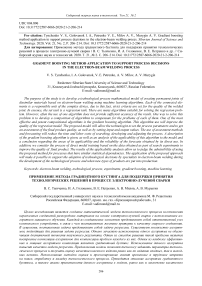Gradient boosting method application to support process decisions in the electron-beam welding process
Автор: V. S. Tynchenko, I. A. Golovenok, V. E. Petrenko, A. V. Milov, A. V. Murygin
Журнал: Siberian Aerospace Journal @vestnik-sibsau-en
Рубрика: Informatics, computer technology and management
Статья в выпуске: 2 vol.21, 2020 года.
Бесплатный доступ
The purpose of the study is to develop a technological process mathematical model of creating permanent joints of dissimilar materials based on electron-beam welding using machine learning algorithms. Each of the connected elements is a responsible unit of the complex device, due to this fact, strict criteria are set for the quality of the welded joint. In essence, the set task is a regression task. There are many algorithms suitable for solving the regression problem. However, often the use of one algorithm does not provide sufficient accuracy of the result. One way to solve this problem is to develop a composition of algorithms to compensate for the prob-lems of each of them. One of the most effective and potent compositional algorithms is the gradient boosting al-gorithm. This algorithm use will improve the quality of the regression model. The proposed model will allow the technologist to set the process parameters and to get an assessment of the final product quality, as well as by setting input and output values. The use of assessment methods and forecasting will reduce the time and labor costs of searching, developing and adjusting the process. A description of the gradient boosting algorithm is given, as well as an analysis of the applicability of this algorithm to the model and a conclusion regarding the areas of its applicability and the reliability of the forecasts obtained by its direct use. In addition, we consider the process of direct model training based on the data obtained as part of search experiments to improve the quality of final product. The results of the applicability analysis allow us to judge the admissibility of using the proposed method for processes that have similar statistical dependencies. The application of the proposed ap-proach will make it possible to support the adoption of technological decisions by specialists in electron-beam welding during the development of the technological process and when new types of products are put into pro-duction.
Electron-beam welding, technological process, experiments, gradient boosting, machine learning.
Короткий адрес: https://sciup.org/148321739
IDR: 148321739 | УДК: 004.896 | DOI: 10.31772/2587-6066-2020-21-2-206-214
Список литературы Gradient boosting method application to support process decisions in the electron-beam welding process
- Braverman V. Ya., Belozertsev V. S., Litvinov V. P., Rozanov O. V. [Issues of managing weld formation in electron beam welding]. Sibirskiy zhurnal nauki i tekhnologiy. 2008,. Vol. 2 (19), P. 148–152 (In Russ.).
- Weglowski M. S., Blacha S., Phillips A. Electron beam welding – Techniques and trends – Review. Vacuum. 2016, Vol. 130, P. 72–92.
- Zlobin S. K., Mikhnev M. M., Laptenok V. D., Seregin Yu. N., Bocharov A. N., Tynchenko V. S., Dolgopolov B. B. [Automated equipment and technology for soldering waveguide paths of spacecraft]. Sibirskiy zhurnal nauki i tekhnologiy. 2014, No. 4 (56), P. 219–229 (In Russ.).
- Murygin A. V., Tynchenko V. S., Laptenok V. D., Emilova O. A., Seregin Y. N. Modeling of thermal processes in waveguide tracts induction soldering. IOP Conference Series: Materials Science and Engineering. 2017, Vol. 173, No. 1, P. 012026.
- Aydin K., Kaya Y., Kahraman N. Experimental study of diffusion welding/bonding of titanium to copper. Materials & Design. 2012, Vol. 37, P. 356–368.
- Kurashkin S. O., Tynchenko V. S., Seregin Y. N., Petrenko V. E., Milov A. V., Murygin A. V. Mathematical models of beam input and output in the process of electron beam welding of thin-walled structures. Journal of Physics: Conference Series. 2020, Vol. 1515, P. 052048.
- Tynchenko V. S., Milov A. V., Bukhtoyarov V. V., Kukartsev V. V., Tynchenko V. V., Bashmur K. A. The concept of an electron beam I/O control system to optimize the weld formation in the process of electron beam welding. Journal of Physics: Conference Series. 2019, Vol. 1399, No. 4, P. 044092.
- Duffy N., Helmbold D. Boosting methods for regression. Machine Learning. 2002, Vol. 47, No. 2–3, P. 153–200.
- Goodfellow I., Bengio Y., Courville A. Deep learning. Cambridge, MA, MIT press, 2016, 318 p.
- Son J., Jung I., Park K., Han B. Tracking-by-segmentation with online gradient boosting decision tree. Proceedings of the IEEE International Conference on Computer Vision. 2015, P. 3056–3064.
- Peter S., Diego F., Hamprecht F. A., Nadler B. Cost efficient gradient boosting. Advances in Neural Information Processing Systems. 2017, P. 1551–1561.
- Salakhutdinova K. I., Lebedev I. S., Krivtsova I. Ye. [Gradient boosting algorithm for decision trees in the software identification problem]. Nauchno-tekhnicheskiy vestnik informatsionnykh tekhnologiy, mekhaniki i optiki. 2018, Vol. 18, No. 6, P. 1016–1022 (In Russ.).
- Dyakonov I. D., Novikova S. V. [Solution of the forecasting problem with the help of gradient boosting over decision trees]. Nauchnyy forum: Tekhnicheskiye i fiziko-matematicheskiye nauki. 2018, P. 9–12.
- Pedregosa F., Varoquaux G., Gramfort A., Michel V., Thirion B., Grisel O., Vanderplas J. Scikit-learn: Machine learning in Python. The Journal of Machine Learning research. 2011, Vol. 12, P. 2825–2830.
- VanRossum G., Drake F. L. The python language reference. Amsterdam, Netherlands, Python software foundation. 2010, 162 p.
- Schapire R. E., Freund Y. Boosting: Foundations and algorithms. Kybernetes. 2013, Vol. 42, No. 1, P. 164–166.


